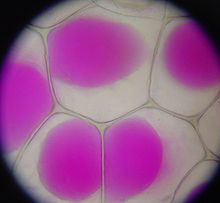Lysis
Lysis (/ˈlaɪs[invalid input: 'i-']s/ LY-səs; Greek λύσις lýsis, "a losing" from λύειν lýein, "to unbind") refers to the breaking down of the membrane of a cell, often by viral, enzymic, or osmotic (that is, "lytic" /ˈlɪt[invalid input: 'i-']k/ LIT-ək) mechanisms that compromise its integrity. A fluid containing the contents of lysed cells is called a lysate. In molecular biology, biochemistry, and cell biology laboratories, cell cultures may be subjected to lysis in the process of purifying their components, as in protein purification, DNA extraction, RNA extraction, or in purifying organelles.
Many species of bacteria are subject to lysis by the enzyme lysozyme, found in animal saliva, egg white, and other secretions.[1] Phage lytic enzymes (lysins) produced during bacteriophage infection are responsible for the ability of these viruses to lyse bacterial cells.[2] Penicillin and related β-lactam antibiotics cause the death of bacteria through enzyme-mediated lysis that occurs after the drug causes the bacterium to form a defective cell wall.[3] If cell wall is completely lost, the bacterium is referred as a protoplast if penicillin was used on gram-positive bacteria, and spheroplast when used on gram-negative bacteria.
Cytolysis
Cytolysis occurs when a cell bursts due to an osmotic imbalance that has caused excess water to move into the cell.
Cytolysis can be prevented by several different mechanisms, including the contractile vacuole that exists in some paramecia, which rapidly pump water out of the cell. Cytolysis does not occur under normal conditions in plant cells because plant cells have a strong cell wall that contains the osmotic pressure, or turgor pressure, that would otherwise cause cytolysis to occur.
Oncolysis
Oncolysis refers to the destruction of neoplastic cells or of a tumour.
It's also used to refer to the reduction of any swelling.[4]
Plasmolysis

Plasmolysis is the contraction of cells within plants due to the loss of water through osmosis. In a hypertonic environment, the cell membrane peels off of the cell wall and the vacuole collapses. These cells will eventually wilt and die unless the flow of water caused by osmosis can stop the contraction of the cell membrane.[5]
Immune response
Erythrocytes' hemoglobin release free radicals in response to pathogens when lysed by them. This can damage the pathogens.[6][7]
Applications
Cell lysis is used in laboratories to break open cells and purify or further study their contents. Lysis in the laboratory may be affected by enzymes or detergents or other chaotropic agents. Mechanical disruption of cell membranes, as by repeated freezing and thawing, sonication, pressure, or filtration may also be referred to as lysis. Many laboratory experiments are sensitive to the choice of lysis mechanism; often it is desirable to avoid mechanical shear forces that would denature or degrade sensitive macromolecules, such as proteins and DNA, and different types of detergents can yield different results. The unprocessed solution immediately after lysis but before any further extraction steps is often referred to as a crude lysate.[8][9]
For example, lysis is used in western and Southern blotting to analyze the composition of specific proteins, lipids, and nucleic acids individually or as complexes. Depending upon the detergent used, either all or some membranes are lysed. For example, if only the cell membrane is lysed then gradient centrifugation can be used to collect certain organelles. Lysis is also used for protein purification, DNA extraction, and RNA extraction.[8][9]
See also
References
- ^ P. Jollès, ed. (1996). Lysozymes--model enzymes in biochemistry and biology. Basel: Birkhäuser Verlag. pp. 35–64. ISBN 978-3-7643-5121-2.
- ^ Nelson, D.; Loomis, L.; Fischetti, V. A. (20 March 2001). "Prevention and elimination of upper respiratory colonization of mice by group A streptococci by using a bacteriophage lytic enzyme". Proceedings of the National Academy of Sciences. 98 (7): 4107–12. Bibcode:2001PNAS...98.4107N. doi:10.1073/pnas.061038398. PMC 31187. PMID 11259652.
- ^ Scholar, E. M.; Pratt, W. B. (2000). The antimicrobial drugs (2nd ed.). Oxford University Press. pp. 61–64.
- ^ "Oncolysis". Medical Dictionary. Farlex. Retrieved 27 March 2013.
- ^ "Wiley InterScience : Journals : New Phytologist". www3.interscience.wiley.com. Archived from the original on May 22, 2011. Retrieved 2008-09-11.
{{cite web}}: Unknown parameter|deadurl=ignored (|url-status=suggested) (help) - ^ Red blood cells do more than just carry oxygen. New findings by NUS team show they aggressively attack bacteria too., The Straits Times, 1 September 2007
- ^ Jiang N, Tan NS, Ho B, Ding JL; Tan; Ho; Ding (October 2007). "Respiratory protein-generated reactive oxygen species as an antimicrobial strategy". Nature Immunology. 8 (10): 1114–22. doi:10.1038/ni1501. PMID 17721536.
{{cite journal}}: CS1 maint: multiple names: authors list (link) - ^ a b Thermo Scientific Pierce Cell Lysis Technical Handbook (PDF) (2 ed.). Thermo Scientific.
- ^ a b "Protein Expression and Purification Core Facility: Protein Purification: Extraction and Clarification". European Molecular Biology Laboratory. Retrieved 17 March 2015.
